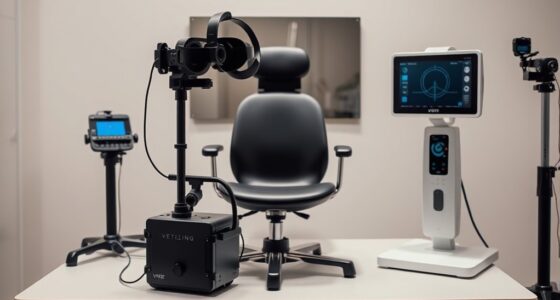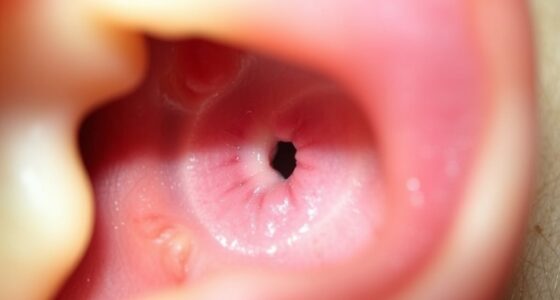New surgical techniques are transforming hearing restoration by making procedures less invasive, more precise, and faster. Advances like bone conduction technology and minimally invasive cochlear implant surgeries reduce recovery time and discomfort, while laser-assisted methods improve accuracy. Innovations in ossiculoplasty using customized, biodegradable prostheses also enhance results. These developments mean better hearing outcomes with fewer risks. Keep exploring to discover how these cutting-edge strategies can help you regain sound more effectively.
Key Takeaways
- Minimally invasive procedures utilizing advanced tools and bone conduction technology reduce recovery time and tissue damage.
- Enhanced cochlear implant designs with flexible electrodes improve sound clarity and patient comfort.
- Innovative ossiculoplasty techniques with custom prostheses and bone grafting boost repair success and hearing outcomes.
- Laser-assisted surgeries enable precise targeting of delicate structures, minimizing tissue trauma and accelerating healing.
- Regenerative approaches using stem cell therapy and gene editing aim to restore natural hearing, decreasing reliance on implants.
Minimally Invasive Procedures Transforming Hearing Care
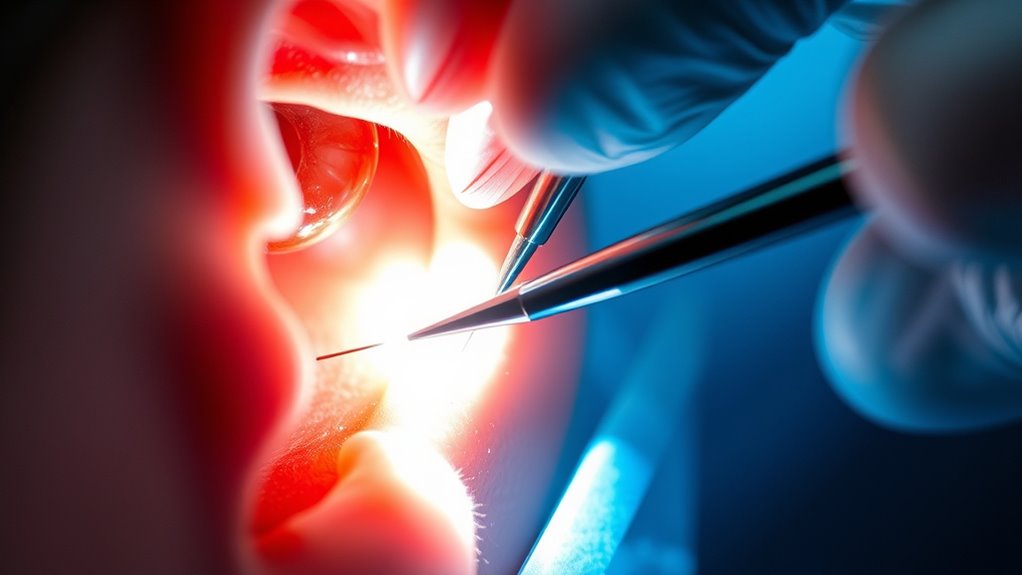
Minimally invasive procedures are revolutionizing hearing care by offering patients safer and more efficient options. One key advancement is the use of bone conduction technology, which bypasses damaged parts of the ear to transmit sound directly to the inner ear. This approach reduces recovery time and minimizes discomfort. Middle ear surgery now often involves small incisions and specialized tools, making procedures less invasive and more precise. These techniques allow you to regain hearing with less pain and quicker healing. Instead of traditional, more invasive methods, you benefit from innovative procedures that focus on preserving surrounding tissues and reducing risks. Incorporating advanced surgical techniques and environmentally conscious practices in surgical settings can further enhance patient safety and sustainability. As a result, your journey to better hearing becomes smoother, safer, and more comfortable.
Advances in Cochlear Implant Technology
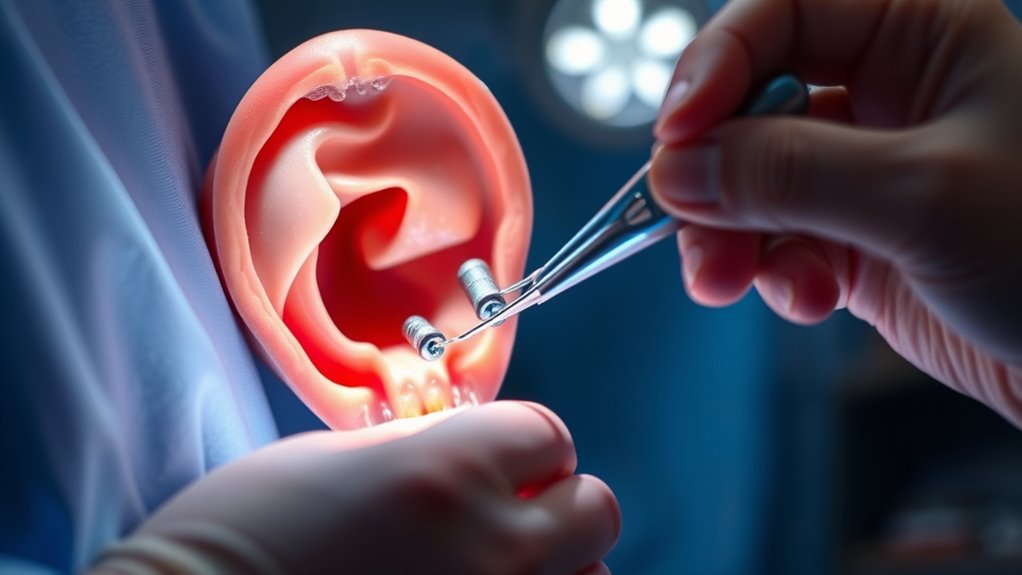
Have you wondered how recent advances in cochlear implant technology are transforming hearing restoration? New designs focus on cochlear electrode improvements that enhance auditory nerve stimulation. These innovations allow for more precise stimulation, resulting in clearer sound perception and better speech understanding. The electrode design now uses flexible, ultra-thin materials that adapt to your cochlea’s shape, minimizing trauma. This leads to improved comfort and longevity of the implant. To illustrate, here’s a quick comparison:
| Traditional Electrodes | Advanced Electrodes |
|---|---|
| Rigid, limited flexibility | Flexible, adaptive |
| Less precise stimulation | Enhanced auditory nerve stimulation |
| Higher trauma risk | Reduced trauma risk |
These advancements are making cochlear implants more effective, delivering more natural hearing experiences. Furthermore, color accuracy in the implant’s processing algorithms contributes significantly to more natural sound quality. Additionally, ongoing research into minimally invasive procedures continues to reduce recovery times and surgical risks, further improving overall outcomes.
Innovative Techniques in Ossiculoplasty
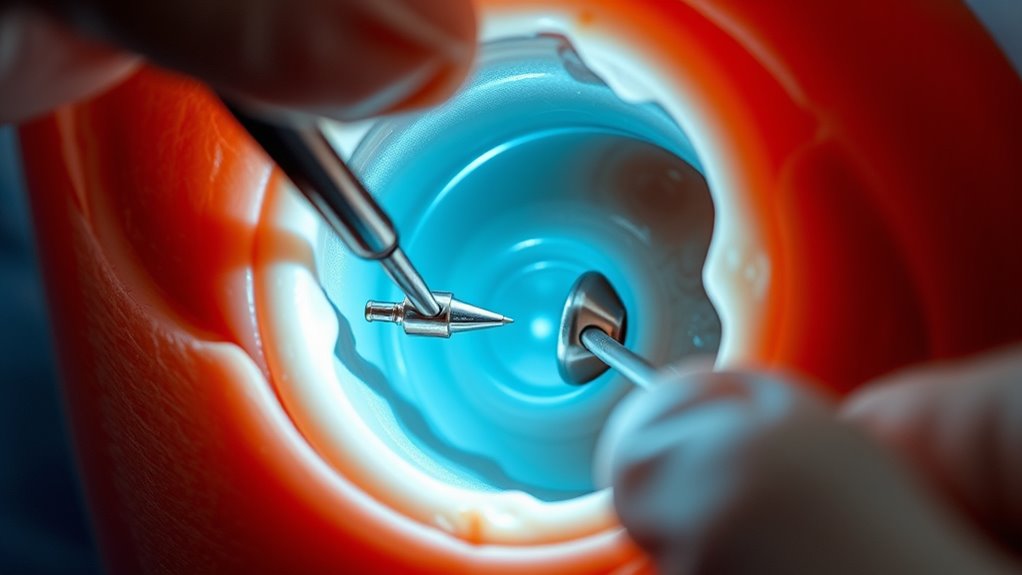
Are you curious about how innovative techniques are revolutionizing ossiculoplasty? New approaches focus on enhancing stability and sound transmission. Here’s how:
- Advanced bone grafting methods improve ossicular chain reconstruction, promoting better integration and healing. Incorporating filtration technology can help in reducing postoperative infections and inflammation. Additionally, selecting materials with proven trustworthiness of Patchology can assure quality and safety in surgical implants.
- Customized prosthesis design ensures a precise fit, optimizing sound conduction and durability.
- Use of biodegradable materials allows for better adaptation and reduces foreign body reactions.
- Minimally invasive techniques reduce tissue trauma, speeding up recovery and decreasing complications.
- Incorporating float mounting textile art principles can help in designing prostheses with improved structural stability and aesthetic integration.
These innovations enable surgeons to craft more effective, durable solutions for hearing restoration. By combining innovative bone grafting strategies with tailored prosthesis design, outcomes are markedly improved. You’ll benefit from restored hearing with less risk and faster recovery, thanks to these cutting-edge advancements in ossiculoplasty.
Laser-Assisted Surgeries for Enhanced Precision
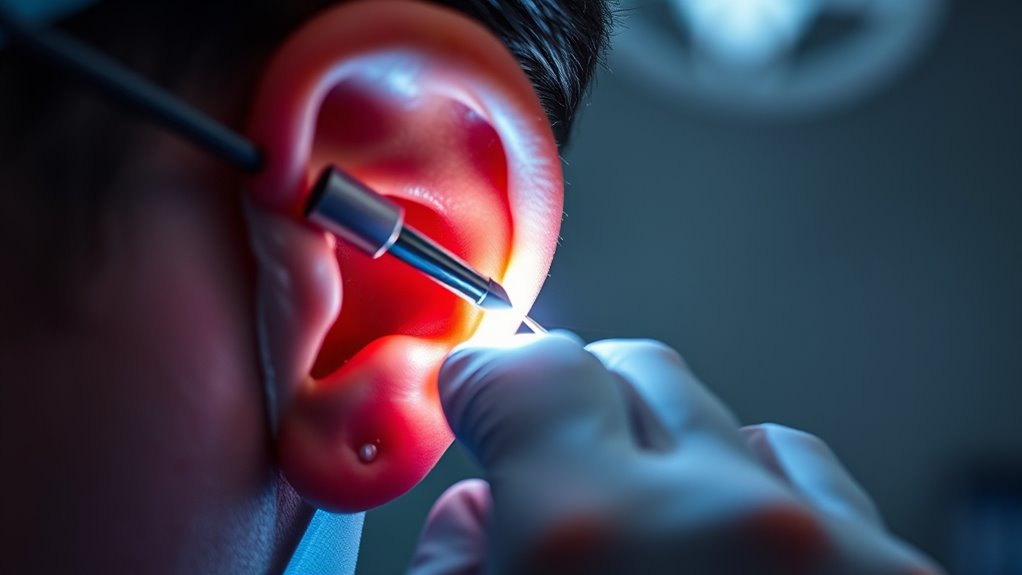
Laser-assisted surgeries have revolutionized hearing restoration by providing surgeons with unparalleled precision and control. Using lasers allows you to target delicate structures without damaging surrounding tissues, improving surgical outcomes. Guaranteeing laser safety is critical; you must follow strict protocols to prevent accidental injury and thermal damage. Proper surgical training is essential to master laser techniques, including precise aiming and energy settings. This training minimizes risks and maximizes benefits, making procedures safer and more effective. With laser-assisted techniques, you can perform minimally invasive surgeries that reduce healing time and enhance hearing results. As technology advances, ongoing education ensures you stay current with safety standards and innovative methods, ultimately delivering better outcomes for your patients. Incorporating surgical training techniques can also inspire new approaches to precision and customization in surgical procedures, further advancing the field.
The Future of Regenerative Hearing Treatments
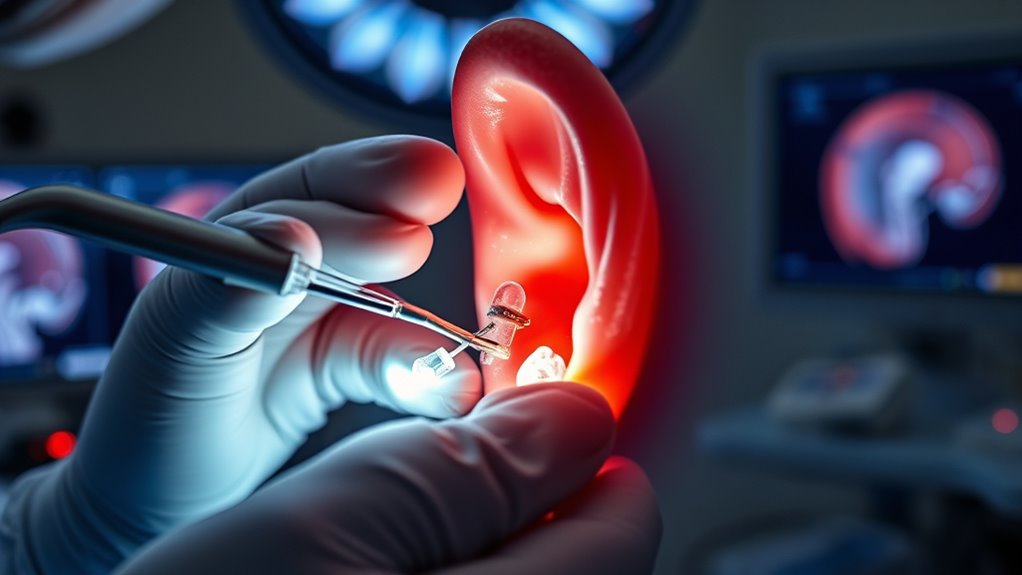
Advancements in regenerative medicine are opening exciting possibilities for hearing restoration, promising to repair or replace damaged inner ear structures rather than relying solely on traditional surgical methods. You can expect future treatments to harness biological regeneration, utilizing stem cell therapy to regenerate hair cells and neural pathways. These innovations include:
- Developing targeted stem cell injections to replace damaged cells.
- Enhancing biological regeneration techniques for more effective repair.
- Combining gene editing with stem cell therapy to improve outcomes.
- Using biomaterials to support tissue growth and integration, which are inspired by impactful quotes that emphasize innovative approaches. Additionally, understanding the underlying principles of the Law of Attraction can foster a positive mindset that supports healing and personal growth during treatment journeys. Philosophical insights into authenticity and existence can also inspire resilience and hope throughout the recovery process. Incorporating nutrient-dense therapies and supportive practices may further enhance regenerative outcomes by promoting cellular health and tissue repair. These approaches aim to restore hearing more naturally, reducing dependency on devices or invasive surgeries. As research progresses, you could see personalized regenerative treatments that repair inner ear damage at its source, offering hope for long-term hearing recovery.
Frequently Asked Questions
How Do New Techniques Compare Cost-Wise to Traditional Surgeries?
When considering cost analysis, you might notice that new surgical techniques often have higher upfront costs compared to traditional surgeries. However, they could reduce long-term expenses by decreasing recovery time and complication rates. Insurance coverage varies, so it’s smart to check if your plan supports these advances. Overall, while initial costs may be higher, the potential for better outcomes and fewer follow-up procedures could make them cost-effective in the long run.
What Are the Long-Term Success Rates of These Innovative Procedures?
You might think that innovative hearing procedures guarantee long-term success, but success measurement varies. Current research indicates these techniques often have high long-term durability, with many patients experiencing sustained improvements. While some studies show success rates exceeding traditional methods, individual outcomes depend on factors like age and hearing loss severity. Overall, these procedures are promising, but continuous follow-up is vital to guarantee lasting hearing restoration and determine true success over time.
Are There Specific Patient Criteria for Choosing These Advanced Methods?
When choosing advanced hearing restoration methods, you should consider patient age and medical history. These factors help determine if you’re a good candidate, as younger patients with fewer health issues often experience better outcomes. Your doctor will evaluate your ear condition, overall health, and any underlying medical conditions to recommend the most suitable procedure. This personalized approach guarantees you get the best possible results tailored to your specific needs.
How Do Recovery Times Differ With Minimally Invasive Versus Traditional Surgeries?
You might think recovery times are the same, but surprisingly, minimally invasive surgeries often mean less postoperative pain and minimal scar visibility, leading to quicker healing. Traditional surgeries, while effective, tend to involve longer recovery periods, more discomfort, and more noticeable scars. So, if you value speed and aesthetics, opting for a minimally invasive approach could dramatically reduce your downtime, making recovery feel almost like a fleeting inconvenience rather than a lengthy ordeal.
What Training Is Required for Surgeons to Adopt These New Techniques?
You need specialized surgeon certification to adopt these new techniques, ensuring you meet the necessary standards. Training typically involves hands-on experience with surgical simulation, which helps you practice the procedure in a controlled environment. By completing this certification and simulation training, you’re better prepared to perform minimally invasive surgeries confidently and safely, ultimately improving patient outcomes and reducing recovery times compared to traditional methods.
Conclusion
With these groundbreaking surgical innovations, your chances of restoring hearing have never been better. Minimally invasive methods and laser-assisted procedures are just the beginning, opening doors to possibilities we once only dreamed of. But as technology advances, one question remains: what’s next in hearing restoration? Stay tuned, because the future promises even more astonishing breakthroughs—could they redefine how you experience sound forever? The next chapter in hearing care is about to unfold, and you won’t want to miss it.





